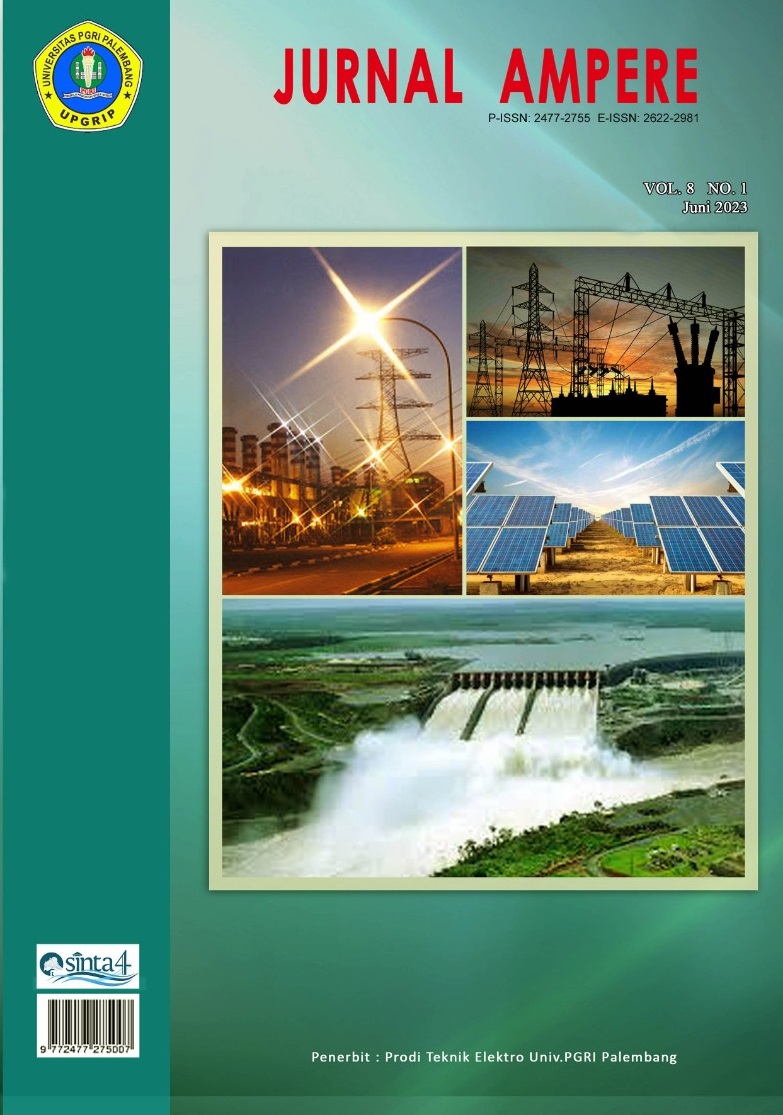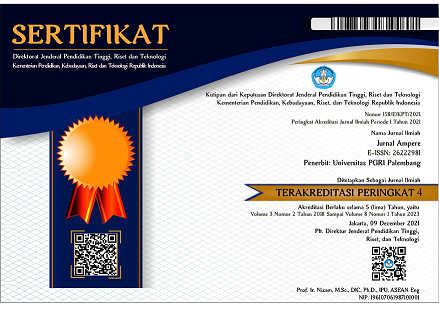Analisis Perbaikan Jatuh Tegangan Pada Sistem Transmisi 150kV Gardu Induk Cerme Menggunakan Aplikasi Digsilent
DOI:
https://doi.org/10.31851/ampere.v8i1.11635Keywords:
Voltage Drop, Voltage Quality, DigSilentAbstract
The electrical quality, especially voltage fluctuations, is very important to remain stable in supplying voltage to consumers. PT. PLN (Persero) has a minimum voltage limit of -5% and a maximum of +10% which is regulated in the Minister of Energy and Mineral Resources no. 3 of 2007 in the transmission system. However, the 150 KV transmission system often experiences voltage drops caused by conductors that are too long and inappropriate loads, so that in maintaining good transmission quality, a reliable system is needed. One of them is GI Cerme which has a double busbar type, which separates the two Java-Bali transmission sub-systems and is connected to supplies from West Surabaya GI and Lamongan GI. Even so, the Lamongan-Cerme network with a length of 26.77KMS and transformer load causes a voltage drop, in the case that occurred in April 2023 at GI Cerme at peak load it experienced a voltage drop of up to 137 KV, so it is necessary to overcome the voltage drop problem the transmission system was repaired at GI Cerme. Through the digsilent application, it is possible to simulate better system planning at GI Cerme so that the voltage can be repaired according to standards.
References
S. WALUYO, W., SEPGIANTO, G. A., & SAODAH, “Studi Gangguan Hubung Tanah Stator Generator Menggunakan Metoda Harmonik Ketiga di PT. Indonesia Power UP. Saguling,” REKA ELKOMIKA, vol. 4, no. 2, 2016.
R. Indonesia, Peraturan Menteri Energi Dan Sumber Daya Mineral No. 3 Tahun 2007 tentang ATURAN JARINGAN SISTEM TENAGA LlSTRlK JAWA-MADURA-BALI. Sekretariat Negara. Jakarta, 2007.
A. Kurniawan, “Analisa jatuh tegangan dan penanganan pada jaringan distribusi 20 kv rayon palur pt. pln (persero) menggunakan etap 12.6 publikasi ilmiah,” p. 15, 2016, [Online]. Available: http://eprints.ums.ac.id/50011/
Arsuyono, “Analisis Perbaikan Jatuh Tegangan (Voltage Drop) Pada Penyulang Lubuk Jambi Di Area Pelayanan Pt. Pln (Persero) Ulp Taluk Kuantan,” pp. 1–131, 2021.
D. Y. Sukma and Hermanto, “Perbaikan Jatuh Tegangan pada Feeder Jaringan Distribusi Tegangan Menengah 20 kV Teluk Kuantan,” Jom FTEKNIK, vol. 4, no. 1, pp. 1–8, 2017.
G. Putra, “Analisa Perbaikan Tegangan Pada Saluran Transmisi.,” 2014.
M. Ihwanudin, “SIMULASI GANGGUAN VOLTAGE SAG DAN VOLTAGE SWELL PADA JARINGAN 20 KV MENGGUNAKAN MATLAB SIMULINK,” quateknika, vol. 8, no. 2, pp. 1–15, 2018.
A. D. Prasetyo, B. Sirait, and Purwoharjono, “Upaya Perbaikan Jatuh Tegangan pada Jaringan Distribusi Tegangan Menengah PT. PLN (Persero) Rayon Tumbang Titi Ketapang,” J. Tek. Elektro Univ. Tanjungpura, vol. 2, no. 1, 2017.
PLN, Buku Pedoman Pemeliharaan Kapasitor. 2014.
M. Saini, M. Y. Yunus, R. Akbar, and M. Yassir, “ANALISIS JATUH TEGANGAN PADA SISTEM KELISTRIKAN 150 kV SULSELRABAR MENGGUNAKAN DIGSILENT POWERFACTORY 15,” J. Sinergi Jur. Tek. Mesin, vol. 16, no. 2, p. 200, 2019, doi: 10.31963/sinergi.v16i2.1514.
Downloads
Published
How to Cite
Issue
Section
License
Copyright (c) 2023 Raka Trialviano Bagus, Denny Irawan

This work is licensed under a Creative Commons Attribution-ShareAlike 4.0 International License.

Jurnal Ampere is licensed under a Creative Commons Attribution-ShareAlike 4.0 International License.
Authors who publish with this journal agree to the following terms:
- Authors retain copyright and grant the journal right of first publication with the work simultaneously licensed under a Creative Commons Attribution License that allows others to share the work with an acknowledgement of the work's authorship and initial publication in this journal.
- Authors are able to enter into separate, additional contractual arrangements for the non-exclusive distribution of the journal's published version of the work (e.g., post it to an institutional repository or publish it in a book), with an acknowledgement of its initial publication in this journal.
- Authors are permitted and encouraged to post their work online (e.g., in institutional repositories or on their website) prior to and during the submission process, as it can lead to productive exchanges, as well as earlier and greater citation of published work.






